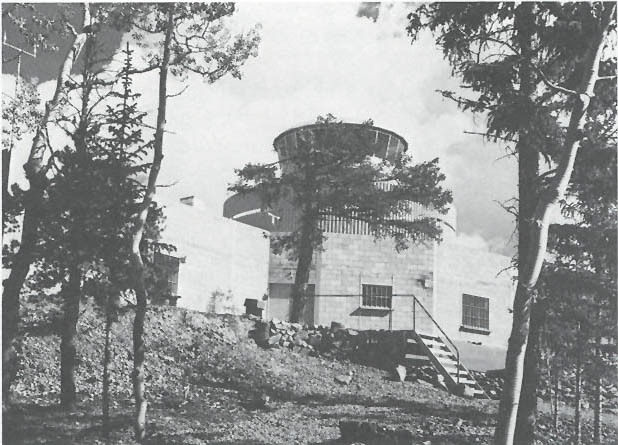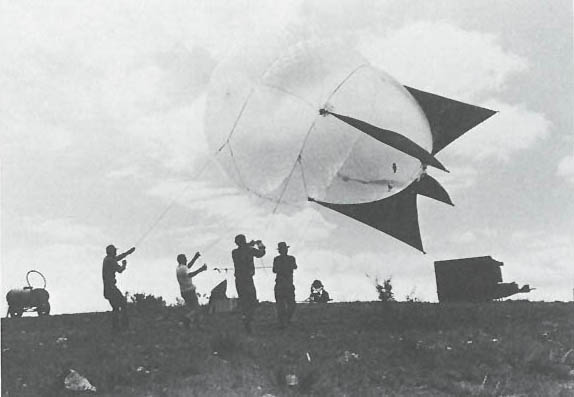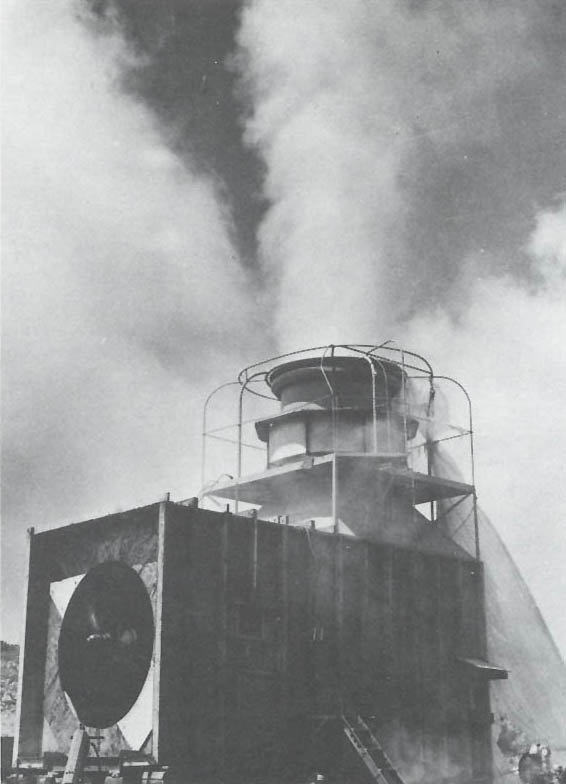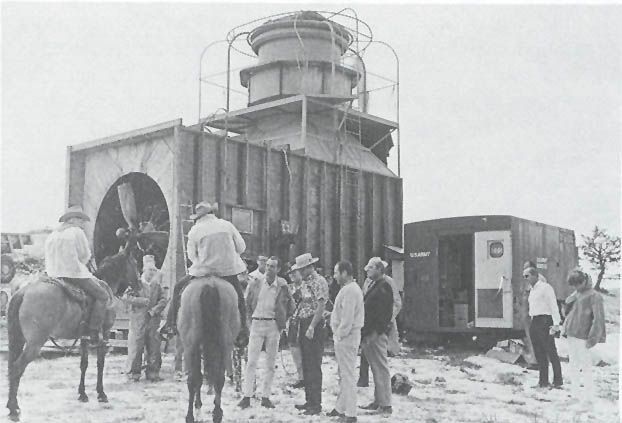6
The Sorcerer's Apprentice
By the time the lab's construction began, Marx Brook had been at Tech for six years and was beginning to work his way in earnest up the professional ladder. In a university, this is done largely by publishing articles in peer-reviewed professional journals. Between 1960 and 1962, Brook published a dozen papers on lightning in the Journal of Geophysical Research, working in cooperation with Workman and a Japanese professor named Nobu Kitagawa. They photographed lightning, recorded the changes in electric fields associated with it, and used radar to try to correlate it with other phenomena. In the dry season, they pored over their data and wrote papers, concentrating on the fine structure of the lightning flash and on what that might imply about the electrical structure of the cloud.
Brook and his collaborators also looked at lightning, often from the top of Socorro Peak, the site of one of their radars. One stroke that Brook and Vonnegut saw in a distant thunderstorm in 1958 was quite unusual. The normal lightning flash is composed of several events--most notably cloud-to-ground leaders and ground-to-cloud return strokes. The return strokes are the bright ones that onlookers perceive. As a rule, the successive stages are so short that they cannot be distinguished by an observer. This time, for some reason, things happened so slowly that the return strokes and the upwardly moving streamers could be counted with the naked eye. They wrote in the Journal of Geophysical Research, "It is refreshing, in this age of data-taking machines and digitalizing devices, to be able to report a simple visual observation which appears to have scientific worth."
Brook's emphasis on visual observation, on occasionally sticking one's head out of the radar room and looking at a thunderstorm, was understandable; he was an avid scientific photographer at a time when many of his colleagues were enchanted by their electrical instruments. He still takes pictures of lightning when he can, but he now has much more company. The various phenomena observed at Langmuir are now photographed by everything from time-lapse cameras that take a picture every five minutes to a Fastax camera, meant for filming explosions, that unreels 6,000 frames per second with a screech like a dentist's drill.
Even after the construction of the lab, Brook continued working on Socorro Peak and in Socorro, as did many of his colleagues. They now had a permanent mountaintop lab started, but it was not going to do them much good for a few years until it was properly equipped.
At Langmuir Laboratory, as in atmospheric research everywhere, logistics was a major problem. Despite the attentions of Kempton and his crew, the path to the lab was still rough and rocky. The people who worked at Langmuir became experts at packing fragile apparatus so securely that it probably could have been shipped parcel post. They learned those skills one pickup truckload at a time.
But the real problem was the "learning curve," not the curves in the road. Loading the apparatus onto a truck, driving it up the side of a mountain, and putting it in the lab were only three small links in a long chain of events. For the most part, one does not pick up a catalog and order atmospheric physics apparatus. Much of the equipment at Langmuir is either "home-brew" or converted military surplus. Making your own equipment and converting military surplus both start with applied physics: what are you looking for, how much of it do you expect to find, and how can you measure it? Catch-22 smirks at the researchers who do not have the equipment to get the data they need to design the equipment.
The winters pass quickly in experimental atmospheric physics. Designs must be revised, and next year's money must be sought. This year's equipment may be ready by the year after next. The equipment progresses through design engineering, skilled assembly work, testing, and usually redesign and more testing.
Time, money, and more and more people become involved. Scientists watch the thunderstorm season come and go from their workshops as the problems multiply. Electronic equipment fails illogically and turns out to have been wired up improperly. The telephone rings. One of the area newspapers wants to send a reporter down. A rancher thinks the research work is causing a flood; another suspects it is causing a drought. Do you suppose you could spare a few minutes? Eventually a piece of apparatus is completed and is ready to be hauled up the mountain.
So went the early sixties. Marvin Wilkening was the chairman of the Langmuir Laboratory Committee from 1963 through 1969. A surprisingly modest and self-effacing man for all his achievements, Wilkening says that he got the job only because Workman was too busy to do it himself. (The remark also shows a certain understanding of Workman's personality.) Yet Wilkening was named as the co-principal investigator in the proposal to build the lab, and as chairman he took time away from his own interest in atmospheric radioactivity to oversee projects in cloud physics and lightning.
Wilkening was a veteran researcher by that time, having come to the School of Mines in 1948, fresh from his doctoral work at the Illinois Institute of Technology in Chicago. During World War II he had worked on the Manhattan Project. He started with Enrico Fermi's atomic-pile group at the University of Chicago, moved on to Oak Ridge, Tennessee, where uranium 235 was being separated from uranium 238, then went to Richland, Washington, where plutonium 239 was being purified for a different type of atom bomb. His Manhattan Project days culminated in 1945 with an assignment to Los Alamos. When the first-ever bomb went off on July 16, 1945, at Trinity Site, Wilkening was there.
When the Manhattan Project was disbanded, Wilkening resumed his interrupted studies at Illinois Tech, earning his master's and doctoral degrees in only three years. But after living in Los Alamos, even shacky wartime Los Alamos, Wilkening and his wife found the crowds and weather of Chicago unpleasant. He knew that he enjoyed teaching and also wanted to go into research. A phone call to Dr. John Harty, then head of the physics department at the New Mexico School of Mines, showed him the way out of Chicago and into a research professorship. He wasted little time in accepting.
At the School of Mines, Wilkening was taken under the tutelage of Dr. William Crozier, who worked at the fringes of atmospheric physics. Crozier was primarily a meteoriticist, a student of meteorites, which was an important and exotic field in those pre-Apollo days. Crozier also studied the formation of aerosols, or suspensions of tiny particles in the atmosphere; this field was of more immediate interest to the atmospheric physicists, because a cloud is an aerosol. Wilkening went with him to Mount Withington to study the radioactivity of aerosols.
Wilkening's work in this relatively unexplored area involved the measurement of radionuclides to trace air movements. These radioactive variants of common atoms are present in tiny amounts throughout the air. Their radioactivity makes them findable with the Geiger counter and its more sophisticated descendants. Since these radionuclides are blowing in the wind along with other atoms, they can be used to trace airflow between thunderstorms, over mountain ridges, and so forth.
That research on Mt. Withington brought Wilkening into contact with Moore and Vonnegut in the mid-fifties. It happens that radionuclides often exist in the atmosphere as positive ions. Moore and Vonnegut were interested in any kind of charged particles floating around in the atmosphere because the separation of positively charged particles from negatively charged ones is what allows lightning to occur. With Wilkening's help, they studied the behavior of the positive ions of radon and other radioactive gases under the influence of the storms' electric fields.
A long-lasting personal and professional elationship resulted from this cooperation, though the work was more directly profitable for Wilkening than for Vonnegut and Moore, because ionized radon is not a significant factor in cloud electrification. Thus, when the time came to build a permanent mountaintop lab, it was only natural for Wilkening to become involved. He helped scout out the territory when the scientists were trying to decide between Baldy and Withington; then he suggested the layout for much of the road on Baldy.
As running the newly constructed lab began to take up more and more of his time, Wilkening inevitably began using the lab as a base of operations for his own research. One of his major projects, done with the assistance of graduate student Dave Rust, involved tracing the airflow over and around the mountain ridges. A box of anemometers left over from that project still remains at the lab. It is practically a law of physics: a body that has been moved up to Langmuir tends to remain at Langmuir. Moore sometimes gets a mad gleam in his eye and hauls off a truckload of apparatus that has outlived its usefulness. But Wilkening's anemometers, dusty, cobwebbed, some eviscerated for other projects, are still there. One never knows when something like that might come in handy.
|
|
|
Langmuir Lab in 1964, brand new and
uninstrumented. |
Even when Wilkening's projects were not actually conducted at Langmuir, he benefited from the work done there, and the lab benefited from his research as well. That kind of interaction is one of the factors that makes the lab effective. A single flight over the mountaintop might take air samples, record wind speeds, and drop puffs of aluminum "chaff" to reflect someone else's radar. In the mid-seventies, visiting French scientists shot rockets to trigger lightning for American projects, and, in turn, shared the American data. A student driving a jeep up from Socorro makes the rounds of the Tech campus to see if anything needs to go up the mountain. In Langmuir parlance, this is known as "involving people in the decision loop."
As the sixties progressed, the decision loops at Langmuir grew larger and more complex. The biggest single change came in 1964 when Workman retired. (His retirement was short-lived; he soon went to the University of Hawaii at Hilo and founded a cloud physics observatory there.) The man who had rebuilt New Mexico Tech in his own image was replaced as president by former Lawrence Livermore National Laboratory scientist Stirling Colgate.
Colgate, first and foremost an astrophysicist, served as president until 1974, when he resigned in the midst of a personal scandal. He was not a strict administrator. Where Workman had maintained stern discipline, Colgate allowed virtually any kind of personal behavior.
For better or worse, Colgate's presidency changed the character of the school, especially insofar as the students were concerned. Workman's reign had been marked by strict yet unwritten rules of conduct. Once, some students were caught drinking beer in their parked car and throwing the empty bottles out the window. Workman impounded their car for the rest of the semester. But although Workman restricted personal freedom in some ways, he enhanced it in others. He provided freedom from having to lock the doors at night, for example, and freedom from having to worry about cheating on examinations. There was never any formal honor code; honor was practiced but not preached in Workman's day, when certain things were simply not done by gentlemen. By 1964 that attitude was already a dusty anachronism held in place by the sheer force of Workman''s personality. To blame its demise solely on Colgate, as some have done, is to grossly oversimplify a complicated situation.
Although his reputation was made in astrophysics, Colgate was interested in many aspects of the physical sciences. Soon he gravitated toward the new atmospheric physics facility. Both directly and indirectly, Colgate was responsible for much of the progress that was made at Langmuir during the late sixties and early seventies.
But Colgate was not alone. Charles Moore, a de facto member of Tech since the mid-fifties, left the Arthur D. Little Company in 1965 for a position on the Tech faculty. Colgate had ideas for things to build; Moore has always loved to build things. Between them, the lab was in for a great period of growth.
The boom times at Langmuir started in 1966. By that time, the original lab building was getting rather crowded. Between the machine shop and the living quarters for the resident scientists, there was precious little space for research equipment. Moore and physics professor William Hume wrote a proposal to the National Science Foundation that year, asking for money to build an annex to the lab. Their work was a masterpiece of proposal writing. One of the illustrations was a glowing pen-and-ink drawing, an architect's conception of a second lab building.
Another illustration, a black-and-white picture of dilapidated instrument trailers beneath a bleak gray sky, might as well have been a woodcut from Oliver Twist. The proposal netted $117,000 worth of sympathy from the NSF to erect the research building that came to be known as the Annex.
Other buildings went up on South Baldy at about the same time. The helium-filled balloons that were so important in the research work were being damaged or destroyed at their moorings when storms passed by in the night. Deflating the balloons each night and then re-inflating them in the morning would obviously have been impractical. A balloon hangar, erected in 1968, solved the problem. Also helpful was a truck-mounted balloon winch acquired from the Navy. The scientists had been carrying balloons around with a surplus DUKW amphibious vehicle, or "duck," that happened to have a winch on top. (Until its removal in 1984, the duck sat near the lab at an elevation of about 10,400 feet, which is probably a record for such a vehicle. Although retired from research for several years, the duck had remained as an invaluable conversation piece and the inspiration for innumerable flood jokes.)
But the most scientifically significant construction projects of the Colgate years had to do with cloud electrification. In 1960, in the cornfields of Illinois, Vonnegut and Moore had released space charge from elevated high-voltage wires. Airborne measurements had proven that the space charge was being carried up at 1,000 feet per minute or more when convective clouds were overhead. Unfortunately, none of the clouds they tried to charge up ever developed into thunderstorms. Similar experiments on Mount Withington had been unsuccessful because the wires, strung across the canyons, had been destroyed by the storms.
Now that Langmuir Lab had been built, Moore and Vonnegut had a grand opportunity to continue these experiments on a much larger scale, with sturdy apparatus, in a place where storms were sure to hit. They needed more than just successful partial results; they needed concrete data, backed up by extensive measurements, that could be obtained time and time again.
|
|
|
Handling a balloon on South Baldy,
circa 1965. |
The first device built at Langmuir for this purpose was "Stirling's cloud machine." The machine consisted of a barn-like structure with a 1,200-horsepower airplane engine and propeller in one end and a chimney on top. When a storm passed over the ridge between Baldy and the lab, the engine was fired up and lubricating oil was injected into its exhaust. This produced clouds of smoke that were blown past a grid of high-voltage electrodes. From out of the chimney came billows of greasy space charge headed for the cloud at a high velocity. (The Forest Service was not informed of all the oily details of how the machine worked.)
At first, Stirling's cloud machine did not have a name, but an irreverent student took care of that. To ensure that the electrified smoke all went into the cloud, Colgate developed a sheet-plastic sleeve that would unroll like a party favor when hit by the air blast from the airplane engine. The student took one look and bestowed upon it the acronym of PBC. Visitors speculated about what PBC might stand for. Particulate Burner/Charger, perhaps? When they saw it in operation, they realized that PBC stood for Paul Bunyan's Condom. Colgate's device resembled nothing so much as a hundred-foot inflatable prophylactic.
Alas, the 1,200-horsepower contraption was not rigid enough to stand erect in the winds of a thunder-storm, so it was removed and the smoke was allowed to blow straight up from the chimney. Instruments for measuring the electrical effects of the smoke were installed on a cherry picker next to the machine. When Moore went up into the smoke cloud on the cherry picker, sparks would fly from his eyebrows. Although both versions of the machine put out impressive amounts of space charge, there was no way to account for the role of ground effects in the results. The scientists could not tell for certain what effect, if any, their cloud of smoke had on the thunderstorms; Moore suspects that it had about as much effect as a blowtorch would have on an iceberg.
|
|
||||
|
"Stirling's could machine" minus the PBC. New Mexico Tech Archives. |
The PBC in action. |
In 1968, with the aid of NSF money that came with the grant to build the Annex, the scientists went back to the original idea of releasing space charge from an elevated wire. This time, though, it would be done right. A little more than a mile of high-strength, half-inch-diameter steel cable was strung between a tower near the lab and another tower on Timber Ridge, two kilometers away on the other side of Sawmill Canyon. Since no road could be built along the top of Timber Ridge, the materials for the tower had to be taken to the site with pack mules and helicopters. After two summers of hard work in rough terrain, the cable finally hung across Sawmill Canyon. Made of special high-strength steel, it was suspended at each end from a six-foot insulator under 6,000 pounds of tension. It could be electrified with up to 150,000 volts when a promising cloud came near.
The cable produced some spectacular sparks. It also produced an interesting bit of lab folklore when the orange aircraft markers on it slipped down to the bottom of the catenary curve, and graduate student Larry Boucher went out on the cable in a bosun's chair to re-anchor them.
Unfortunately, the electrified cable produced such large local electrical anomalies that its effects on the clouds were obscured. Many investigators complained bitterly about this, so further cable experiments were postponed until an instrumented airplane capable of penetrating the clouds for direct measurements could be obtained.
The cable fell down during an ice storm in 1981. Over a mile of it lay in the bottom of Sawmill Canyon, wrapped around sixty-foot trees and needle cliffs. It was retrieved, with great difficulty, during the summer of 1984. By then an airplane known as SPTVAR I, the Special Purpose Test Vehicle for Atmospheric Research, was instrumented and ready to fly, and good results finally began to come in.
Other important additions to the lab were made in the late sixties. A spring in the bottom of Sawmill Canyon was equipped with a dam and a pump, and a water line to the lab, some 2,000 feet above, was installed. In 1969 came a three-centimeter radar on a tower atop the Annex. The radar, meant for cloud physics studies, scanned the entire sky vertically in horizon-to-horizon wedges like the segments of half an orange.
At about the time of the cable project, Colgate was beginning to drift back into astrophysics. He was and is interested in supernovae, the cataclysmic outpourings of energy at the collapse and death of very large stars. Supernovae are so rare that astrophysicists must search other galaxies for them. This is laborious and time-consuming work. Colgate had a brainstorm: why not build an automated telescope on Baldy that would check all of the visible galaxies several times each night?
That was easier said than done. The job involved automatically pointing a telescope very precisely at each of several thousand galaxies twice a night, measuring their brightness, comparing the brightness to a previously recorded value, and marking any great variations. It was a plausible idea, because a galaxy with a supernova in it is about twice as bright as usual for a few days. But building the automated telescope proved to be a phenomenally complex task.
Colgate started with the steel liner from a Titan missile silo. Atop the liner he built a clamshell housing for the telescope and its aiming apparatus.
|
|
|
Stirling Colgate, (center,
between
horse and man with camera) gives a tour of the cloud-charger
facility.
|
Once again, a giant phallic symbol reared up a few hundred feet from the lab. Colgate encountered the usual difficulties of erecting a large structure on top of a mountain, but the really hard part was building the electronic controls for the telescope. In fact, this proved impossible for many years.
Today, anyone building such a device would start with a microcomputer. In 1968 there were no microcomputers. Even integrated circuits were in their infancy, and Colgate did not have any. He set out to revolutionize astrophysics with discrete transistors and student labor. It took more than 15 years and many developments in electronic equipment before he finally succeeded. By that time, a team of researchers at the California Institute of Technology in Pasadena had built such a telescope--but they readily acknowledged that Colgate had provided the theoretical basis for their invention.
Of course, the conditions at Caltech in the early eighties were somewhat different from those at Langmuir in the early sixties. For example, Wilkening has a bearskin rug in his home. He shot the black bear himself after it ventured into the lab building one day in 1968.
With all the human activity on Baldy in the past twenty-five years, most of the bears have packed up and gone, as have the mountain lions. But the mountain is still the home of coyotes, a red fox, and George the Squirrel. George, who appeared in 1982, was the pet of Langmuir balloon chief Jack Cobb. "We need him to do our business," he would say as the squirrel ate junk food out of his hand. Moore would occasionally stand behind a tree and make clucking noises like two nuts being clicked together, trying to get George the Squirrel's attention. But the squirrel preferred the parade of people with food in their hands.
There were hazards besides the animals and the ever-present danger of lightning. John Reiche's Turn marks the spot where its namesake barrel-rolled a four-wheel-drive truck and lived to tell about it. Several years later, a riddle was coined about Langmuir "electroniker" Jerry Longmire. The riddle asked, "What's white and lies on its back with all four wheels in the air?" The answer: Jerry Longmire's jeep, which he had parked without chocking up the wheels.
In later years, these vehicles would be joined in the TERA boneyard by a new Chevy Blazer (flipped, somehow, on one of the flattest parts of the road by an astrophysics graduate student, who had a curve named "Adrian's Adios" in his honor) and by an old Dodge pickup that Colgate's wife forgot to chock up. No lives were lost on the Langmuir road until 1985, when a visitor died in an alcohol-related accident, but close calls have been all too frequent. The fact that no lab personnel have been killed or seriously injured on duty stands as testimony to excellent safety precautions--and to luck.
Next: Chapter 7 -- The Dream Thunderstorm
Previous: Chapter 5 -- The Research Finds a Home





